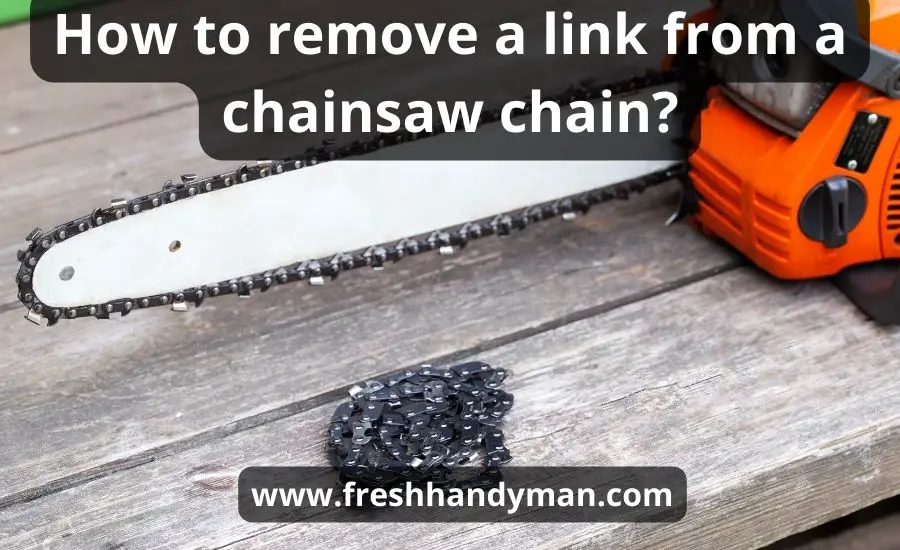How to remove a link from a chainsaw chain? Chainsaws are powerful equipment that is essential for various cutting and trimming tasks, especially in tree work and similar outdoor projects.
The intricate arrangement of chainsaw links of the chainsaw chain plays a vital role in the overall performance of the Oregon chain products.
Over time, chainsaw chains may become stretched or damaged, requiring adjustment or replacement.
In this comprehensive guide, we will delve into the intricate world of chainsaw chains, exploring the process of how to take a link from a chainsaw chain.
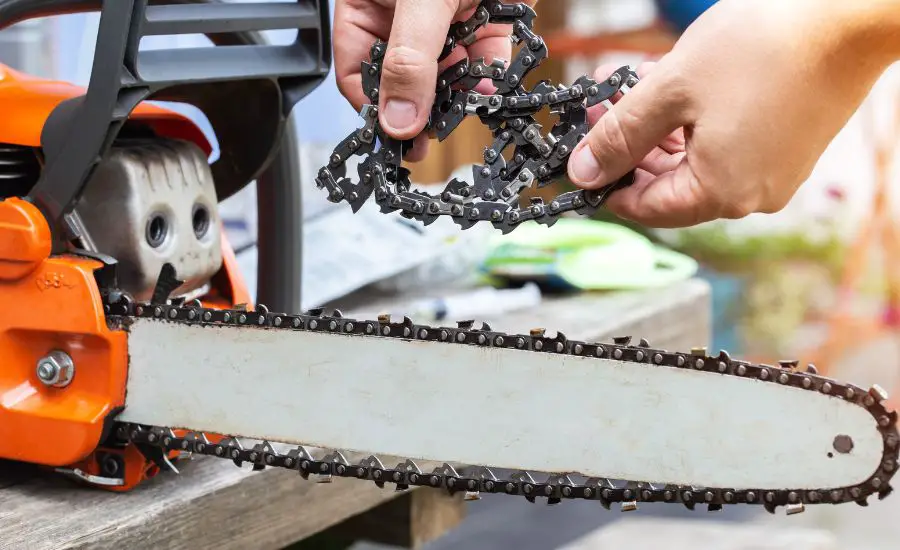
After the instructions, it will equip you with the knowledge and skills to maintain your chainsaw chain in the best possible condition.
Understanding a chainsaw chain
Before we dive into the nitty-gritty of removing links from a chainsaw chain, it’s essential to have a fundamental understanding of the key components involved.
Chainsaw chains
A chainsaw chain consists of a series of links of the chains that wrap around a guide bar, creating a rotating cutting edge.
These chains are typically constructed from high-quality steel and are designed to withstand the rigors of cutting through wood and other tough materials.
The links of the chain
Chainsaw chain links are the individual components that make up a chainsaw chain.
All the links interlock to form a continuous loop, allowing the chainsaw chain to move smoothly around the guide bar.
Each link plays a crucial role in maintaining the chain’s integrity and cutting performance.
The tension of the chain
Proper chain tension is vital for safe and efficient chainsaw operation. A well-tensioned chain ensures that it remains securely on the guide bar while cutting.
Chain tension can change over time as the chain stretches or wears, making periodic adjustments required.
Stretched chain
Chainsaw chains are susceptible to stretching due to the high forces and friction they endure during operation. A stretched chainsaw chain can result in reduced cutting efficiency and safety concerns.
Hence, it’s essential to address this issue promptly.
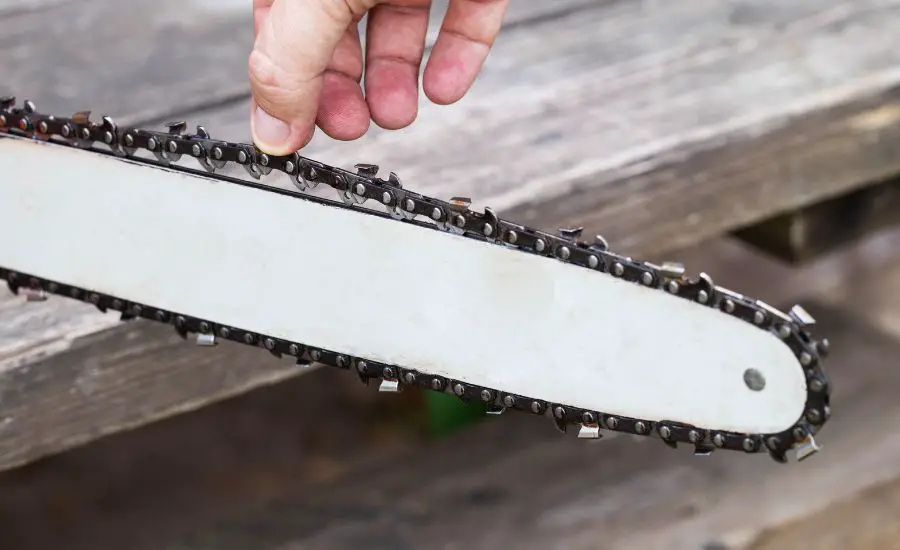
Tools for the job
The right tools
Taking a link from a chainsaw chain requires the application of specific equipment designed for this purpose. The primary tools you will need include:
Chain breaker: a specialized tool applied to disassemble and reassemble a chainsaw chain.
Needle nose vice grip: used for gripping and holding small components like the links of chains.
Channel locks: ideal for securing the chainsaw’s chain during the elimination.
Special rivet tool: needed for connecting the chainsaw chain links back together after modification.
Having these tools at your disposal is essential for a successful chain link removal operation. In case you do not have certain tools, you can acquire them from a hardware store.
The process of removing a link
The main process of taking a link is presented below.
Safety measures
Prior to discussing how to take a link from a chainsaw chain, it’s crucial to emphasize the importance of safety. Working with chainsaws and their chains can be dangerous. Always follow these safety measures:
- A spark plug should be unplugged and the chainsaw should be switched off.
- Have appropriate safety gear, including gloves and eye protection.
- Work on a stable surface with proper support for the chainsaw.
Assess the chain
The chainsaw chain should first be examined to see whether it needs to have a chain shortening or if any links are broken.
If the entire chain is damaged, it may be time for a new chain, but for minor issues or size adjustments, you can proceed with taking a link.
Identify the master link
The master link is a unique chain link that is made to be easily removable, allowing you to take apart the chain. It usually has a different appearance compared to the other links, often featuring a clip or a different shape.
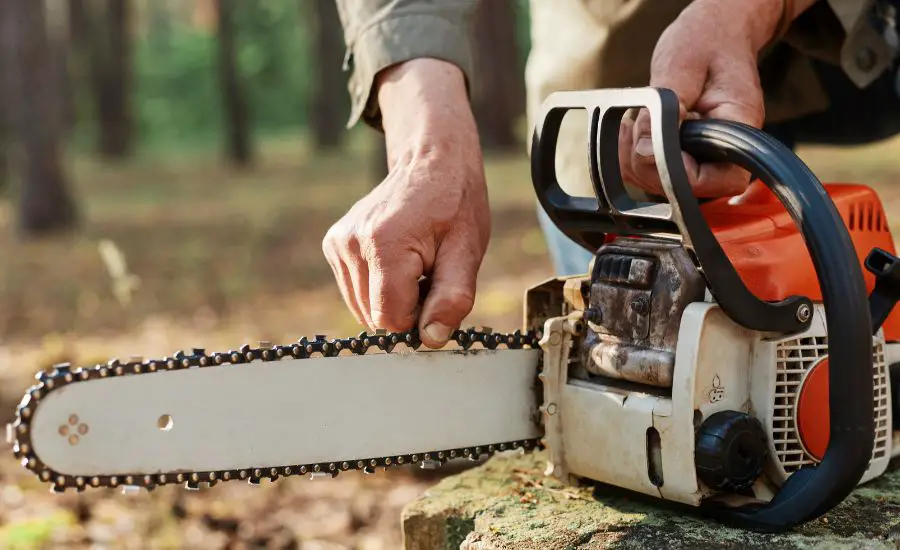
How to remove the master link
Using the needle nose vice grip, carefully open the clip on the master link. Gently push the clip’s open ends apart and slide it out of other links.
This will remove the master link from the chain, allowing you to separate the chain into two sections with a chain breaker.
Shorten the chain
Choose the chainsaw chain length you want, making sure it is of the correct length for your chainsaw type and guide-size chain bar. It will vary depending on your specific requirements and the tasks you perform.
Removing other links
If it is necessary to take more other links to reach the desired length, redo the process for the other chain links. Make sure that you take a link of an equal number from each side of the chain to maintain balance and proper tension.
Reconnecting the chain
The following steps show how to reconnect the chain.
Reconnecting with the master link
When you have finished to shorten the chain to the proper length, it’s time to reconnect it.
Slide the master link back into place, ensuring it aligns with the adjacent links.
Using the special rivet tool
To secure the master link in place, use the rivet tool. The equipment will press the link’s pins together, creating a secure and reliable connection. Follow the manufacturer’s instructions for your specific rivet tool to ensure proper installation.
Chain tension and final checks
These are the last acts of checking prior to finishing.
Chain tensioning
When the chain is reconnected, it’s essential to look at the tension of the chain. Proper chain tension is crucial for safe and efficient chainsaw operation. Refer to your chainsaw’s manual for specific tensioning instructions, as it can vary among different chainsaw models.
But in most cases, it is necessary just to tension the chain tight.
The snap test
One common method for checking the tension of the chain is the snap test. In order to do this test, manually tension the chain and lift it away from the guide bar with the disconnected spark plug. The chainsaw passes the test if the chain snaps back into place when released.
If it doesn’t, adjust the tension until it does.
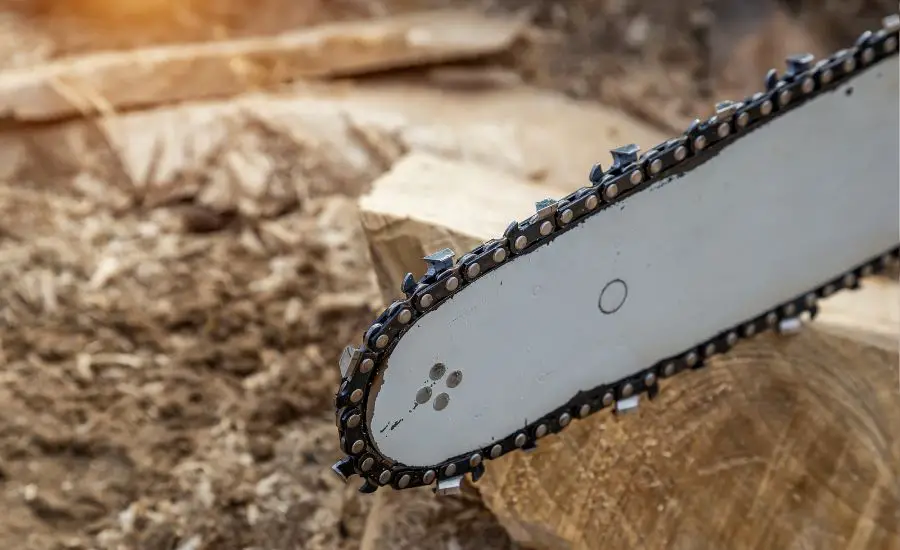
Additional tips and considerations
Below are several additional but nevertheless substantial tips.
Different master links
Chainsaw chains come in various designs, and some may have different types of master links. It’s essential to identify the specific master link used in your chain before attempting to take a link. Consult your chainsaw’s manual or the chain manufacturer’s instructions for guidance.
Chains without a master link
In some cases, you may encounter chains that do not have a master link. In order to take a link from such chains, you may require the services of a professional chainsaw technician.
Attempting to modify a chain without a master link can lead to safety hazards and damage to the chain.
When to replace the chain
During the process of taking links that can extend the life of your chainsaw chain, there will come a moment when it’s no longer practical to replace it. A chainsaw chain has a finite lifespan, and if it is severely stretched, damaged, or worn, it’s best to replace it with a new chain.
Consult your chainsaw’s manual for guidance on chain replacement intervals.
Maintaining your chainsaw chain
Now that you’ve learned how to take a link from a chainsaw, it’s essential to understand how to maintain your chains for long-term performance and safety. Proper maintenance can extend the life of your chain, enhance cutting efficiency, and reduce the need for frequent adjustments and repairs.
Regular cleaning
After each use, make it a habit to clean the chains.
Remove sawdust, dirt, and debris from the chain links and guide bar.
A clean chain not only operates more efficiently but also reduces the risk of premature wear and damage.
Chain sharpening
Maintaining a sharp cutting edge is crucial for the performance of your chainsaw. Regularly inspect the chain’s teeth, and if you notice signs of dullness, invest in a quality chain sharpening kit or take it to a professional sharpening service. Sharp chains cut faster and with less effort, reducing strain on your chainsaw.
Lubrication
Proper lubrication is essential to reduce friction and heat buildup in the chain. Ensure the chain oil reservoir is filled before each use and monitor it during operation. Keeping the chain well-lubricated prolongs its life and minimizes the risk of overheating.
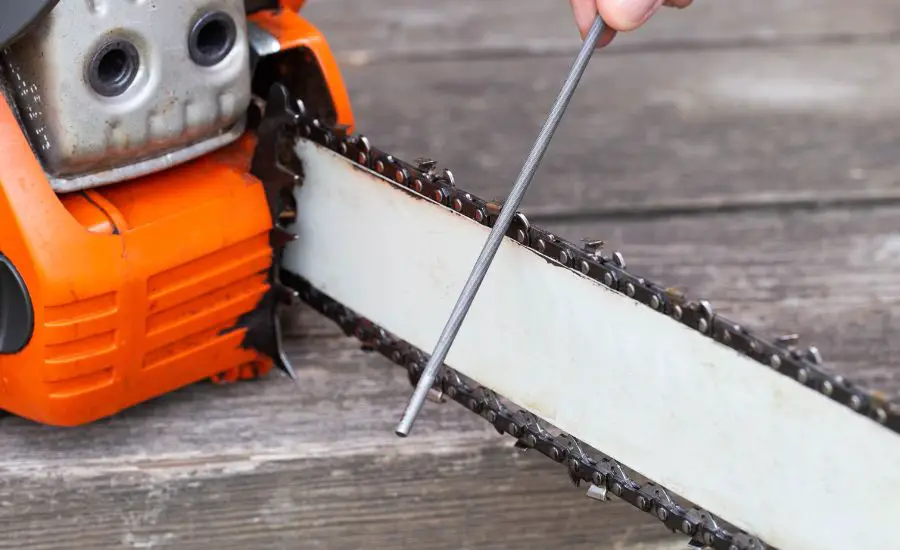
FAQ
Here are presented some of the most commonly asked questions on the topic of this post with the following comprehensive answers.
Do all chainsaw chains have a master link?
No, there isn’t always a master link on chainsaw chains. These links are typically found in chains that are designed for easier disassembly and maintenance. Some chains lack the master link, making them more complicated to modify or repair. It’s important to check your chainsaw chain and consult the manufacturer’s instructions to determine whether it has a master link or not.
How do you separate chain links?
To separate the links of chains, follow these steps:
• Identify the master link, which is designed to be easily removable.
• Using a needle vice grip, carefully open the clip on the master link by pushing the open ends apart.
• Slide the clip out of the link, disconnecting the master link from the chain.
This will allow you to separate the chain into two sections.
For chains without a master link, separation can be more challenging and may require specialized tools or the expertise of a professional chainsaw technician.
How do you fix a bent chainsaw chain?
Fixing a bent chainsaw chain involves straightening the individual links that have become bent or twisted. Here’s a basic process:
• Identify the bent links by visually inspecting the chain.
• Using pliers or channel locks, gently bend the bent links back into their original shape.
• Ensure that all links are properly aligned and not twisted or kinked.
• Reassemble the chain if necessary, following the manufacturer’s instructions or using a master link.
• Finally, check the chain’s tension and make any necessary adjustments before using it again.
For severely bent or damaged chains, it may be safer and more effective to replace the chain with a new one.
How do you unbind a chainsaw?
If your chainsaw becomes bound or stuck in wood while cutting, follow these steps to unbind it safely:
• Turn off the chainsaw immediately and disconnect the spark plug for safety.
• Assess the situation and determine the location and cause of the binding.
• Do not force the chainsaw or attempt to yank it free, as this can be dangerous.
• Carefully and systematically, remove wood from around the chain and guide the bar until the chainsaw is free.
• Once the chainsaw is unbound, inspect the Oregon chain and guide bar for any damage or issues before continuing your work.
Remember that safety is paramount when dealing with bound chainsaws, and taking the time to safely remove the bind is crucial to prevent accidents or damage to your equipment.
Conclusion
Maintaining your chainsaw chain in top condition is essential for safe and efficient cutting performance. Learning how to take a link from a chainsaw chain is a valuable skill that can help you extend the life of your chain and save on replacement costs.
By following the steps outlined in this guide and adhering to proper safety measures, you can confidently tackle the tough job of chainsaw chain maintenance.
With the appropriate tools and knowledge, you’ll be able to keep your chainsaw chain at the correct length, ensuring it remains an extremely helpful tool for all the tree work and outdoor projects.
